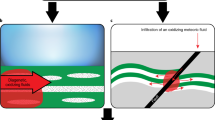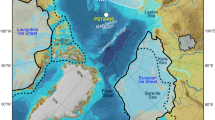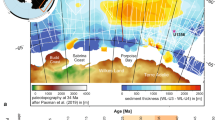Abstract
The meridional extent of marine ice during the Neoproterozoic snowball Earth events is debated. Banded iron formations associated with the Sturtian glaciation are considered evidence for a completely ice-covered, ferruginous ocean (hard snowball). Here, using an ocean general circulation model with thick sea glaciers and Neoproterozoic biogeochemistry, we find that circulation in a partially ice-covered ocean (soft snowball) yields iron deposition patterns similar to the observed distribution of Sturtian banded iron formations.
This is a preview of subscription content, access via your institution
Access options
Access Nature and 54 other Nature Portfolio journals
Get Nature+, our best-value online-access subscription
$29.99 / 30 days
cancel any time
Subscribe to this journal
Receive 12 print issues and online access
$259.00 per year
only $21.58 per issue
Buy this article
- Purchase on Springer Link
- Instant access to full article PDF
Prices may be subject to local taxes which are calculated during checkout



Similar content being viewed by others
Data availability
The model data and the Python script necessary to reproduce the figures presented in this study are available from the figshare repository at https://doi.org/10.6084/m9.figshare.25130783.v1 (ref. 58). The other data that have been analysed can be accessed through the links provided in the studies that have been cited.
Code availability
The simulations are carried out using the MITgcm, an open-source ocean model that can be downloaded from https://mitgcm.readthedocs.io/en/latest/overview/overview.html. The specific model configuration is available upon request.
References
Bekker, A. et al. Iron formation: the sedimentary product of a complex interplay among mantle, tectonic, oceanic, and biospheric processes. Econ. Geol. 105, 467–508 (2010).
Konhauser, K. O. et al. Iron formations: a global record of Neoarchaean to Palaeoproterozoic environmental history. Earth Sci. Rev. 172, 140–177 (2017).
Lyons, T. W., Reinhard, C. T. & Planavsky, N. J. The rise of oxygen in Earth’s early ocean and atmosphere. Nature 506, 307–315 (2014).
Kirschvink, J. L. Late Proterozoic low-latitude global glaciation: the snowball Earth. Proterozoic Biosphere 52, 51–52 (1992).
Hoffman, P. F., Kaufman, A. J., Halverson, G. P. & Schrag, D. P. A Neoproterozoic snowball Earth. Science 281, 1342–1346 (1998).
Evans, D. A. D. Stratigraphic, geochronological, and paleomagnetic constraints upon the Neoproterozoic climatic paradox. Am. J. Sci. 300, 347–433 (2000).
Hyde, W. T., Crowley, T. J., Baum, S. K. & Peltier, W. R. Neoproterozoic ‘snowball Earth’ simulations with a coupled climate/ice-sheet model. Nature 405, 425–429 (2000).
Nelson, L. L. et al. Geochronological constraints on Neoproterozoic rifting and onset of the Marinoan glaciation from the Kingston Peak Formation in Death Valley, California (USA). Geology 48, 1083–1087 (2020).
Rooney, A. D., Yang, C., Condon, D. J., Zhu, M. & Macdonald, F. A. U–Pb and Re–Os geochronology tracks stratigraphic condensation in the Sturtian snowball Earth aftermath. Geology 48, 625–629 (2020).
Hoffman, P. F. et al. Snowball Earth climate dynamics and Cryogenian geology–geobiology. Sci. Adv. 3, e1600983 (2017).
Abbot, D. S., Voigt, A. & Koll, D. The Jormungand global climate state and implications for Neoproterozoic glaciations. J. Geophys. Res. 116, D18103 (2011).
Yang, J., Peltier, W. R. & Hu, Y. The Initiation of modern “soft snowball” and “hard snowball” climates in CCSM3. Part II: climate dynamic feedbacks. J. Clim. 25, 2737–2754 (2012).
Laakso, T. A. & Schrag, D. P. Regulation of atmospheric oxygen during the Proterozoic. Earth Planet. Sci. Lett. 388, 81–91 (2014).
Laakso, T. A. & Schrag, D. P. A theory of atmospheric oxygen. Geobiology 15, 366–384 (2017).
Crockford, P. W. et al. Triple oxygen isotope evidence for limited mid-Proterozoic primary productivity. Nature 559, 613–616 (2018).
Chan, C. S., Emerson, D. & Luther, G. W. The role of microaerophilic Fe‐oxidizing micro‐organisms in producing banded iron formations. Geobiology 14, 509–528 (2016).
Song, H. et al. The onset of widespread marine red beds and the evolution of ferruginous oceans. Nat. Commun. 8, 399 (2017).
Li, Z. X. et al. Assembly, configuration, and break-up history of Rodinia: a synthesis. Precambrian Res. 160, 179–210 (2008).
Yang, J., Peltier, W. R. & Hu, Y. The initiation of modern soft and hard snowball Earth climates in CCSM4. Climate 8, 907–918 (2012).
Ashkenazy, Y. et al. Dynamics of a snowball Earth ocean. Nature 495, 90–93 (2013).
Ashkenazy, Y., Gildor, H., Losch, M. & Tziperman, E. Ocean circulation under globally glaciated snowball earth conditions: steady-state solutions. J. Phys. Oceanogr. 44, 24–43 (2014).
Ashkenazy, Y. & Tziperman, E. Variability, instabilities, and eddies in a snowball ocean. J. Clim. 29, 869–888 (2016).
Lechte, M. A. et al. Subglacial meltwater supported aerobic marine habitats during snowball Earth. Proc. Natl Acad. Sci. USA 116, 25478–25483 (2019).
Marshall, J., Adcroft, A., Hill, C., Perelman, L. & Heisey, C. A finite‐volume, incompressible Navier Stokes model for studies of the ocean on parallel computers. J. Geophys. Res. Oceans 102, 5753–5766 (1997).
McDougall, T. J., Jackett, D. R., Wright, D. G. & Feistel, R. Accurate and computationally efficient algorithms for potential temperature and density of seawater. J. Atmos. Ocean Technol. 20, 730–741 (2003).
Redi, M. H. Oceanic isopycnal mixing by coordinate rotation. J. Phys. Oceanogr. 12, 1154–1158 (1982).
Gent, P. R. & Mcwilliams, J. C. Isopycnal mixing in ocean circulation models. J. Phys. Oceanogr. 20, 150–155 (1990).
Pollack, H. N., Hurter, S. J. & Johnson, J. R. Heat flow from the Earth’s interior: analysis of the global data set. Rev. Geophys. 31, 267–280 (1993).
Valdes, P. J., Scotese, C. R. & Lunt, D. J. Deep ocean temperatures through time. Climate 17, 1483–1506 (2021).
Liu, Y., Peltier, W. R., Yang, J. & Vettoretti, G. The initiation of Neoproterozoic "snowball" climates in CCSM3: the influence of paleocontinental configuration. Climate 9, 2555–2577 (2013).
Zhao, Z., Liu, Y. & Dai, H. Sea-glacier retreating rate and climate evolution during the marine deglaciation of a snowball Earth. Glob. Planet. Change 215, 103877 (2022).
Ashkenazy, Y. & Tziperman, E. A wind-induced thermohaline circulation hysteresis and millennial variability regimes. J. Phys. Oceanogr. 37, 2446–2457 (2007).
Ashkenazy, Y. The surface temperature of Europa. Heliyon 5, e01908 (2019).
Ashkenazy, Y., Sayag, R. & Tziperman, E. Dynamics of the global meridional ice flow of Europa’s icy shell. Nat. Astron. 2, 43–49 (2017).
Losch, M. Modeling ice shelf cavities in a z coordinate ocean general circulation model. J. Geophys. Res. Oceans 113, C08043 (2008).
McKinley, G. A., Follows, M. J. & Marshall, J. Mechanisms of air–sea CO2 flux variability in the equatorial Pacific and the North Atlantic. Glob. Biogeochem. Cycles 18, 1–14 (2004).
Dutkiewicz, S., Sokolov, A. P., Scott, J. & Stone, P. H. A Three-Dimensional Ocean-Seaice-Carbon Cycle Model and Its Coupling to a Two-Dimensional Atmospheric Model: Uses in Climate Change Studies. Joint Program Report Series Report (Massachusetts Institute of Technology, 2005).
MITgcm contributors. Biogeochemistry packages. MITgcm https://mitgcm.readthedocs.io/en/latest/phys_pkgs/phys_pkgs.html#biogeochemistry-packages (2019).
Yamanaka, Y. & Tajika, E. Role of dissolved organic matter in the marine biogeochemical cycle: studies using an ocean biogeochemical general circulation model. Glob. Biogeochem. Cycles 11, 599–612 (1997).
Martin, J. H., Knauer, G. A., Karl, D. M. & Broenkow, W. W. VERTEX: carbon cycling in the northeast Pacific. Deep Sea Res. Part A 34, 267–285 (1987).
Halevy, I., Alesker, M., Schuster, E. M., Popovitz-Biro, R. & Feldman, Y. A key role for green rust in the Precambrian oceans and the genesis of iron formations. Nat. Geosci. 10, 135–139 (2017).
Millero, F. J., Sotolongo, S. & Izaguirre, M. The oxidation kinetics of Fe(II) in seawater. Geochim. Cosmochim. Acta 51, 793–801 (1987).
Komada, T. et al. Dissolved organic carbon dynamics in anaerobic sediments of the Santa Monica Basin. Geochim. Cosmochim. Acta 110, 253–273 (2013).
Mottl, M. J. et al. Warm springs discovered on 3.5 Ma oceanic crust, eastern flank of the Juan de Fuca Ridge. Geology 26, 51 (1998).
Elderfield, H. & Schultz, A. Mid-ocean ridge hydrothermal fluxes and the chemical composition of the ocean. Annu Rev. Earth Planet Sci. 24, 191–224 (1996).
Halevy, I. & Bachan, A. The geologic history of seawater pH. Science 355, 1069–1071 (2017).
Poulton, S. W. & Raiswell, R. The low-temperature geochemical cycle of iron: from continental fluxes to marine sediment deposition. Am. J. Sci. 302, 774–805 (2002).
Wolery, T. J. & Sleep, N. H. Hydrothermal circulation and geochemical flux at mid-ocean ridges. J. Geol. 84, 249–275 (1976).
Hart, R. A. A model for chemical exchange in the basalt–seawater system of oceanic layer II. Can. J. Earth Sci. 10, 799–816 (1973).
Thompson, K. J. et al. Photoferrotrophy, deposition of banded iron formations, and methane production in Archean oceans. Sci. Adv. 5, eaav2869 (2019).
Korenaga, J. in Archean Geodynamics and Environments (eds Benn, K. Mareschal, J.-C. & Condie, K. C.) 7–32 (American Geophysical Union, 2006).
Molina, E., Martínez, M. E., Sánchez, S., García, F. & Contreras, A. Growth and biochemical composition with emphasis on the fatty acids of Tetraselmis sp. Appl. Microbiol. Biotechnol. 36, 21–25 (1991).
Fábregas, J., Patiño, M., Vecino, E., Cházaro, F. & Otero, A. Productivity and biochemical composition of cyclostat cultures of the marine microalga Tetraselmis suecica. Appl. Microbiol. Biotechnol. 43, 617–621 (1995).
Tahiri, M., Benider, A., Belkoura, M. & Dauta, A. Caractérisation biochimique de l’algue verte Scenedesmus abundans: influence des conditions de culture. Ann. Limnol. 36, 3–12 (2000).
Viegas, C. V. et al. Algal products beyond lipids: comprehensive characterization of different products in direct saponification of green alga Chlorella sp. Algal Res. 11, 156–164 (2015).
Anderson, L. A. On the hydrogen and oxygen content of marine phytoplankton. Deep Sea Res. Part I 42, 1675–1680 (1995).
Sharoni, S. & Halevy, I. Geologic controls on phytoplankton elemental composition. Proc. Natl Acad. Sci. USA 119, e2113263118 (2022).
Gianchandani, K. Dataset for “Production of Neoproterozoic banded iron formations in a partially ice-covered ocean” by Gianchandani et al. figshare https://doi.org/10.6084/m9.figshare.25130783.v1 (2024).
Acknowledgements
K.G., H.G. and Y.A. acknowledge the Joint National Natural Science Foundation of China, Israel Science Foundation Research Grant No. 2547/17 and the US-Israel Binational Science Foundation (BSF) Grant No. 2018152. I.H. acknowledges a Starting Grant from the European Research Council (OOID No. 755053). E.T. acknowledges NSF grant 2303486 from the P4CLIMATE programme and DOE grant DE-SC0023134. E.T. also thanks the Weizmann Institute for its hospitality during parts of this work.
Author information
Authors and Affiliations
Contributions
K.G. led the conceptualization, method development, data curation and analysis, and code development and performed the numerical simulations presented in this study. I.H., H.G., Y.A. and E.T. contributed to the conceptualization, method development, supervision and validation of the study. H.G. and Y.A. additionally contributed to project administration, resource management and funding acquisition. Y.A. additionally was involved in software development. K.G. drafted the initial manuscript, and all the authors contributed to the text and participated in the review and approval of the final manuscript.
Corresponding authors
Ethics declarations
Competing interests
The authors declare no competing interests.
Peer review
Peer review information
Nature Geoscience thanks Maxwell Lechte and Lennart Ramme for their contribution to the peer review of this work. Primary Handling Editor(s): James Super, in collaboration with the Nature Geoscience team.
Additional information
Publisher’s note Springer Nature remains neutral with regard to jurisdictional claims in published maps and institutional affiliations.
Supplementary information
Supplementary Information
Supplementary Sections 1–4, Figs. 1–11 and Tables 1–3.
Rights and permissions
Springer Nature or its licensor (e.g. a society or other partner) holds exclusive rights to this article under a publishing agreement with the author(s) or other rightsholder(s); author self-archiving of the accepted manuscript version of this article is solely governed by the terms of such publishing agreement and applicable law.
About this article
Cite this article
Gianchandani, K., Halevy, I., Gildor, H. et al. Production of Neoproterozoic banded iron formations in a partially ice-covered ocean. Nat. Geosci. 17, 298–301 (2024). https://doi.org/10.1038/s41561-024-01406-4
Received:
Accepted:
Published:
Issue Date:
DOI: https://doi.org/10.1038/s41561-024-01406-4



